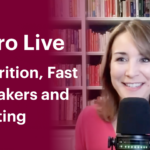Written and medically reviewed by Rich LaFountain, PhD
Exercise is an important pillar of a healthy life, but working it into an intermittent fasting (IF) schedule can take practice. Your schedule could be such that working out during your eating window is more convenient, or you may want to take advantage of the health benefits of working out in a fasted state. Whichever the case may be, read on for helpful guidance on how to pair a fitness practice with your IF habits.

Can You Work Out While Intermittent Fasting?
Working out while intermittent fasting can be safe and sustainable. And if you’re looking to lose weight, fasted exercise can accelerate fat burning, and your fat-burn rate will even remain elevated after your workout. Keep in mind that individual responses to intermittent fasting and exercise may vary. Therefore, it’s worth consulting with your healthcare professional or a fitness expert before making significant changes to your diet or exercise routine.
When to Work Out While Intermittent Fasting
If you’re wondering where to start weaving fitness into your intermittent-fasting lifestyle, consider personal preference, how your energy levels change throughout the day, and factors that affect your schedule, like work and family.
By and large, if you’re going to combine working out and IF, the best time to exercise is when you’re still in a fasted state, making morning or early afternoon the ideal time. This is often referred to as “fasted exercise.” The idea behind fasted exercise is that your body will rely on stored fat for energy, as glycogen — your body’s preferred energy source — is less available after an overnight fast.
Of course, whether you’re fasting or not, morning workouts are popular for a good reason: Research suggests that you’re more likely to form a consistent habit and maintain successful weight loss if you exercise earlier in the day. There are psychological and physiological reasons for this, but one thing is for certain — if you get your workout done first thing, it’s less likely that your busy schedule will dismantle your exercise plans later in the day. If that’s not reason enough, morning exercise is associated with improved mood and increased energy levels throughout the day.
How to Combine Intermittent Fasting and Working Out
Advice for combining IF and working out will differ depending on the type of exercise you prefer or would like to prioritize. Healthy movement patterns include a mixture of low-intensity, moderate-intensity, high-intensity, and strength exercises.
Cardio and Intermittent Fasting
Combining cardio exercise with intermittent fasting can be effective for some individuals, but it’s important to approach it in a way that suits your goals and preferences. Some people prefer fasted cardio in the morning in order to boost fat burn. Others may opt to schedule cardio during their eating window.
If you decide to prioritize cardio workouts during fasting periods, avoid excessive strain on the body by sticking to moderate-intensity cardio, like power walking, zumba, or light jogging. High-intensity workouts may be more challenging without sufficient fuel from recent meals.
Strength Training and Intermittent Fasting
If you’re strength training during your fasting window, plan to consume a well-balanced post-workout meal, rich in protein and natural carbohydrates, to support muscle mass in terms of both growth and recovery. Strength training involves creating mechanical and metabolic damage in the muscle, which when repaired, yields stronger, more resilient tissue. Therefore, it is important that you consume adequate protein each day to support the recovery and rebuilding process so that you’re getting the most from the time you invest in the gym. Work towards consuming 0.7–1.0 grams of protein per pound of body weight each day. Without adequate nutrition, your body may not get maximum benefits from fasted exercise.
Before making significant changes to your exercise routine or fasting schedule, especially if you have any health concerns or specific fitness goals, consult with a healthcare professional or fitness expert for personalized advice. It’s also important to note that individual responses to fasting and strength training can vary, so finding an approach that works for your body and goals is key. Listen to your body and seek professional guidance if needed.
HIIT and Intermittent Fasting
High-intensity interval training (HIIT) can be a quick and efficient way to work out. However, combining it with intermittent fasting is usually considered more challenging than low- or moderate-intensity exercise. When blending HIIT into your fasting schedule, consider the timing of exercise and rest intervals as well as the total duration of your HIIT session. High-intensity workouts can be demanding, and individuals new to fasted exercise might start with shorter bouts of high-intensity exercise with longer rest or active-rest intervals. Gradually build the duration of your exercise and consider reducing the rest interval as you improve.
High-intensity exercise is a great way to improve your overall health. This type of vigorous exercise can help to control appetite. High-intensity exercise is also a very important exercise habit that helps maintain power and speed with increasing age, and it may even enhance your fat-burning capacity. Pay attention to how your body responds to fasted HIIT. If you experience dizziness, weakness, or other signs of discomfort, it’s important to stop and reassess.
Pre-Workout and Post-Workout Nutrition
What you eat after a workout can make or break your health goals, especially if you practice IF. If you’re exercising on fasting days, plan for a well-balanced post-workout meal that emphasizes whole foods with a mix of protein and carbohydrates to support muscle recovery.
Proper Hydration Is a Must
Whether you choose to exercise in a fasted state or not, staying hydrated is crucial. Drink water before, during, and after your workout to maintain hydration levels. Adding electrolytes like sodium and magnesium can further improve the hydration benefits of your water, particularly if you’re hydrating while still fasting. During your eating window, consider drinking diluted coconut water as a natural way to replenish electrolytes.
Prioritize Sufficient Rest and Recovery
Just like hydration, rest is a must no matter what type of fitness regimen you practice. Rest days allow your body to recover, reduce the risk of overtraining, and help prevent injuries. Listen to your body and adjust your training intensity accordingly.
On rest days, consider engaging in leisurely activities you enjoy like walking in nature, recreational swimming, or cycling. These activities can help maintain blood flow to muscles without causing excessive stress. Yoga, foam rolling, and stretching can also be part of a recovery routine that improves flexibility and reduces muscle soreness. These activities also work by enhancing blood circulation while improving mobility.
Benefits of Combining Intermittent Fasting and Exercise
Data suggest that fasted exercise may have positive effects on cardiovascular health, including improvements in blood pressure, cholesterol levels, and endothelial function. There is also evidence to suggest that exercising in a fasted state may have cognitive benefits, including improved focus and mental clarity. However, individual responses can vary.
Fasted exercise can be time efficient, especially for those following time-restricted eating patterns like intermittent fasting. For instance, morning workouts can be integrated into your daily routine without the need for a pre-exercise meal. You can use the time you’d have spent making and eating breakfast working out!
As always, before incorporating fasted exercise into your routine or making significant changes to your diet and exercise habits, it’s a good idea to consult with healthcare professionals or fitness experts. They can provide personalized guidance based on your health status, goals, and individual needs.
Enhanced Fat Burning and Weight Loss
Exercising in a fasted state, especially in the morning before eating, can lead to increased fat oxidation. Put another way: With lower glycogen and insulin levels after an overnight fast, your body’s natural capacity to burn stored fat for energy is unlocked, and exercise can help you make the most of that optimal fat-burning time. Research suggests that the one-two punch of exercise in combination with fasting may double your total weight loss, mainly by cutting fat mass while protecting lean tissue.
Towards the end of your fast and before you enjoy your Fast Breaker is a great time to get moving while your body is primed for fat burning. Timing your exercise this way not only supports weight loss but also helps to improve your circadian rhythm, which in turn leads to a better night of sleep and improves your energy levels for the next day’s exercise session.
Boosted Metabolic Health
Fasted exercise has been shown to improve insulin sensitivity, which is beneficial for blood-sugar regulation. In fact, researchers have found evidence that fasted cardio may help reduce fasting insulin levels better than non-fasted cardio, according to a 6-week study of aerobic exercise in adult men who had overweight or obesity.
Also, whether you do it while fasting or not, exercise can have lasting effects on insulin and blood-glucose levels for hours or even days after you finish your workout. This can be particularly relevant for individuals at risk of or managing type-2 diabetes.
Improved Physical Performance
Intermittent fasting benefits body composition, and by extension, can improve physical-performance markers such as cardiorespiratory fitness (VO2 max). Intermittent fasting has been shown to reduce fat mass, which contributes to increased relative lean mass, or healthy muscle tissue. Whether you are a competitive athlete or not, improved body composition is linked with greater power-to-weight ratio since more of your total body mass is made up of healthy functional muscle rather than fat. Research further suggests that intermittent fasting enables you to decrease body weight, which may contribute to improved physical performance in certain sporting contexts that are weight dependent.
Overcoming Potential Risks and Challenges
Exercising in a fasted state can have potential risks and challenges, and it may not be suitable for everyone. Here are some considerations to keep in mind.
Low Energy Levels
Some individuals may experience noticeable fatigue, dizziness, or lightheadedness during fasted exercise, particularly if they have low blood-sugar levels. This can be a concern for those prone to hypoglycemia. Make sure your diet is rounded out with protein, complex carbohydrates, healthy fats, and fibrous vegetables; drink plenty of water; and prioritize getting healthy sleep to avoid burnout and issues with energy throughout the day.
Overtraining
When it comes to fitness, there is such a thing as overdoing it. Neglecting balanced and adequate nutrition while working out regularly can contribute to muscle-protein breakdown, especially if proper nutrition is not provided post-workout. This could potentially counteract muscle-building goals. The same goes for prioritizing rest: Not taking rest days or overworking your muscles could lead to muscle fatigue, strain, or breakdown. It is important to be honest with yourself about your overall stress level and modulate or reduce exercise if needed to prevent signs and symptoms of overtraining and/or burnout.
Weight-Loss Plateaus
Some individuals may be more prone to overeating later in the day after fasted exercise, which can impact overall caloric balance and dietary goals. Keep an eye on your nutrition and consider the intensity or duration of your exercise routine if you find yourself being dogged by cravings.
Finally, fasted exercise may not be suitable for individuals with certain health conditions, including diabetes, eating disorders, or other metabolic issues. Always check with your healthcare provider before embarking on a change to your fasting or exercise routine.
Ready to start using Zero? Take the quiz or download the app today.
- Debunking 3 Myths Around Fasting and Thyroid Health - April 15, 2024
- Breaking Down Fast Breakers: How to Tell If Something Will Break Your Fast - March 4, 2024
- GLP-1s and Weight-Loss Medications vs. Lifestyle Interventions: What’s Right for You - February 5, 2024






